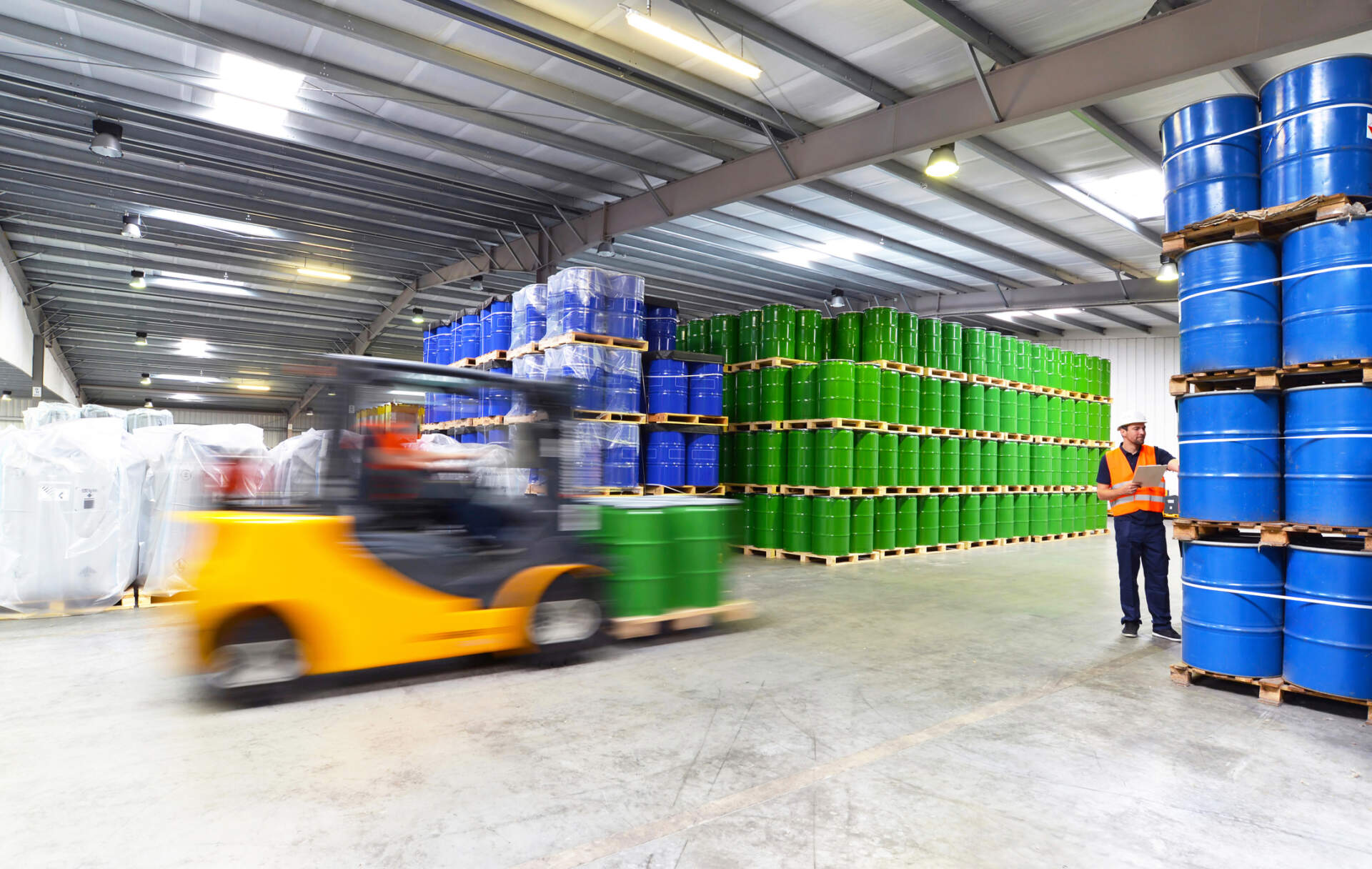
group of workers in the logistics industry work in a warehouse with chemicals – lifting truck
What innovations are making the packaging, shipping, and storing of dangerous goods more safe? See what moves we’re making at Canadian Alliance Terminals in the storage of dangerous and flammable goods here.
Most members of the general public only turn their attention toward hazardous materials on the rare occasions when accidents make headlines. The reason those instances are relatively few and far between is because of supply chain professionals who make safe transportation of dangerous goods a top priority each and every day. Technological and procedural advancements have gone a long way toward making these shipments safer, but there is still a long way to go. Let’s take a look at some developments that have occurred throughout the supply chain.
Packaging of Hazardous Materials for Shipping
Smart technology has been the biggest factor improving packaging for dangerous goods in recent years. RFID tags, QR codes, GPS trackers, digital documentation and IoT sensors provide real time information that is beneficial in ensuring safety and compliance.1
Information on temperature, humidity, pressure, shock, vibration, tilt, and leakage helps shippers know what’s going on with their cargo. When conditions become unsafe, alerts are sent out, allowing for swift action to be taken. Tamper detection is another important safety feature.
Data logging and analytics have helped the industry understand factors and trends that lead to elevated threat levels. When accidents occur, first responders benefit from readily available information on location and status of shipment. As industry 4.0 and the Internet of Things continue to enhance capabilities, it’s important that opportunities are fully leveraged.
Transportation of Dangerous Goods
Regulators, industry professionals, and researchers have been working diligently to prioritize transportation safety, whether by highway, rail, or sky.
By Truck
The same technology that is making our passenger vehicles more safe is also being utilized by truck drivers. Collision avoidance systems, lane departure warning systems, and adaptive cruise control all reduce accidents, enhancing overall safety.
GPS technology is being used by drivers to plan safer routes when handling hazardous materials.
Canada’s ELD mandate, which came into effect in 2021,2 makes it mandatory for certain commercial motor vehicle drivers to record activity using an electronic logging device. By monitoring hours of service and vehicle condition, both human and mechanical errors can be reduced.
By Rail
High profile rail disasters shine the spotlight on railway safety. Each incident that occurs only serves to underscore the imperative to prioritize safety when transporting dangerous goods.
In February 2023, a derailment occurred in East Palestine, Ohio. Several railcars burned for two days, releasing dangerous chemicals into the air, causing concern for those living nearby.3 The incident became a major media event and resulted in renewed debate about appropriate crew sizes and other safety measures regarding US rail transportation.4
Here in Canada, it’s been a decade since the July 2013 freight train crude oil explosion that resulted in the deaths of 47 people in Lac-Mégantic, Quebec.5 As the community commemorated the ten-year anniversary of the disaster earlier this summer, Prime Minister Justin Trudeau reiterated his vow to have a bypass built, diverting trains carrying dangerous goods, preventing them from travelling through downtown.6
Canadian railway shipments are overseen by Transport Canada and are subject to regulations found in the Railway Safety Act.7
Railways must have Safety Management Systems (SMS) in place, emphasizing risk assessment and emergency preparedness. Specific regulations cover the classification, packaging, labeling, and documentation of hazardous materials. Enhanced measures apply to key trains and routes transporting significant quantities of dangerous goods.
By Air
Air shipping of dangerous goods in Canada is also regulated by Transport Canada, primarily through the framework of the Transportation of Dangerous Goods Regulations.
These regulations classify dangerous goods, mandating not only their proper packaging, labeling, and documentation, but also their handling by trained personnel. Emergency Response Assistance Plans (ERAPs) are needed for high-risk materials. Security measures safeguard cargo and compliance is enforced through inspections. TDG Regulations aim to prevent incidents, protect the environment, and ensure the safety of air transportation in Canada.
Warehouse Storage of Dangerous Goods
While great care is paid toward the safe moving of dangerous goods, protocols are often ignored once the materials reach a warehouse.
Canadian Alliance, however, considers safe handling and storage of dangerous goods to be a matter of top importance with respect to employee safety, regulatory compliance, and client peace of mind. Our facility includes two rooms specifically designed for the storage of dangerous goods, one for flammable materials and the other for oxidizers.
Both rooms have a two-hour fire rating and are monitored 24 hours a day. In the flammable storage room, a 14 inch high membrane ensures spill containment. Watch the video here to see a look inside.
“Our strategy as a company is to help our customers identify and mitigate risk,” says CA President William McKinnon. “If we know that there’s a risk, we have a moral and ethical responsibility to deal with it in the most effective, efficient manner possible.”8
The safe movement and storage of dangerous goods is of the utmost importance, both for the supply chain industry and the whole of society. Continuing to promote safety is a matter of marrying technology and ingenuity with good old fashioned diligence.
Canadian Alliance partners with carriers who specialize in the transportation of dangerous goods. By utilizing their services, we can be confident that all compliance standards are exceeded and our customers can rest assured that their cargo is in good hands. It’s just one of the ways that Canadian Alliance Terminals reduces risk and increases customer satisfaction.
If you’re looking for a 3PL partner that goes the extra mile, contact Canadian Alliance for a free consultation today.
Cited Sources
1 Shipping, International. “What Are the Latest Trends and Innovations in Hazmat Packaging and Containers?” Hazmat Packaging and Containers: Trends and Innovations, August 31, 2023. https://www.linkedin.com/advice/0/what-latest-trends-innovations-hazmat-packaging.
2 “Transport Canada Eld Mandate: Electronic Logbook Law.” Geotab. Accessed September 12, 2023. https://www.geotab.com/blog/transport-canada-eld-mandate.
3 “2023 Ohio Train Derailment.” Wikipedia, August 28, 2023. https://en.wikipedia.org/wiki/2023_Ohio_train_derailment.
4 Ryan, Erika. “After the East Palestine Train Derailment, Are Railroads Any Safer?” NPR, August 3, 2023. https://www.npr.org/2023/08/03/1191399657/train-derailment-east-palestine-ohio-norfolk-southern.
5 “Lac-Mégantic Rail Disaster.” Wikipedia, July 31, 2023. https://en.wikipedia.org/wiki/Lac-M%C3%A9gantic_rail_disaster.
6 Press, The Canadian. “Lac-Mégantic Marks 10th Anniversary of Train Derailment That Killed 47 People.” Global News, July 7, 2023. https://globalnews.ca/news/9814445/lac-megantic-rail-disaster-10th-anniversary/.
7 Transport Canada. “The Railway Safety Act.” Transport Canada, July 4, 2019. https://tc.canada.ca/en/rail-transportation/rail-safety-canada/railway-safety-act.
8 Direct Communication with CAT President William McKinnon
